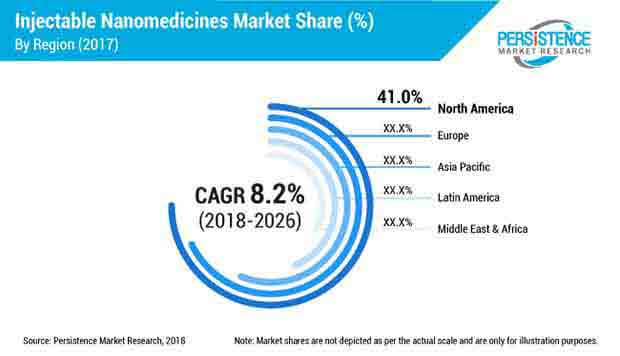Injectable Nanomedicines Market
Industry: Healthcare
Published Date: December-2018
Format: PPT*, PDF, EXCEL
Delivery Timelines: Contact Sales
Number of Pages: 173
Report ID: PMRREP25999
Nanotechnology provides a better safety profiling against drugs with high toxicity. Use of nanotechnology in medicines, specifically drug delivery, is set to increase rapidly. While formulating injectable nanomedicines various strategies can be used to improve the drug delivery and efficacy, e.g. enabling higher therapeutic levels at a target site at lower doses.
The injectable nanomedicines release the drug at the targeted site, and allow accumulation of the drug at the site of action. Bing with ligands increases therapeutic efficacy of injectable nanomedicines enhancing active targeting. Better disease management with targeted drug delivery is estimated to lead to higher demand for injectable nanomedicines.
Design & shape of nanoparticles are gaining major research traction leading to development of better injectable nanomedicines. For instance, liposomal technologies are currently used by key drug manufacturers for extended-release drug delivery thereby reducing dosages.
These include DepoFoam TM Technology, Non-PEGylated Technology (NPL) and others. These technologies improve patient drug adherence through reduced dosing and lesser side effects. Furthermore, rapid adoption of new and complex technologies for developing irreplicable drugs to sustain competition is a factor expected to support revenue growth of injectable nanomedicines market over the forecast period.
A collaboration between academia and pharmaceutical industry is helping the latter to garner higher profits. According to the U.S. National Science Foundation’s 2012 report, 56% of basic research conducted in the U.S. is carried out in academia, whereas 61% of all applied research and 87% of development happens in companies. Scientific and technological expertise coupled with strong academic research ensures better drug development. This factor is expected to boost the injectable nanomedicines industry favorably with faster market outreach.
Globally limited cGMP certified facilities to manufacture complex injectable nanomedicines dampen market’s revenue outlook. Manufacturing of sterile drugs is a critical quality attribute (CQA), as procedural non-conformity may lead to microbial contamination and serious adverse drug reactions (ADRs), including death. Injectable nanomedicines involve the use of nanotechnology for the benefit of human health. Thus, it is very important for manufacturers to develop a suitable sterile manufacturing facility for manufacturing injectable nanomedicines.
Funding on nanomedicines development by governments is steadily increasing, which is attracting more commercialization and development interests from drug makers, making the market more competitive. In this regard, the U.S. Federal Authorities have provided funding worth US$ 1.4 Bn under the National Nanotechnology Initiative, conforming the growing importance and interest on nanomedicines. The growing use of nanomedicines in drug discovery is a major factor expected to drive the revenue growth of the global injectable nanomedicines market over the forecast period.

The competition section of the report features profiles of key players operating in the injectable nanomedicines market based on their market share, product offerings, and differential product marketing strategies. Few key players featured in injectable nanomedicines market report include Merck KGaA, Amgen Inc., Pfizer Inc., Lupin, Janssen Biotech Inc., Hoffmann-La Roche Ltd., Teva Pharmaceutical Industries Ltd., Pacira Pharmaceuticals Inc., Celgene Corporation and Bausch & Lomb Incorporated.
These companies offer a wide range of injectable nanomedicines. Emerging players operating in the injectable nanomedicines market are majorly focusing on new marketing strategies in order to expand their product footprint in the global injectable nanomedicines market.
Major players in the injectable nanomedicine market are investing in R&D for development of innovative nanomedicines, currently there are several injectable nanomedicines under clinical trials and are expected to launch in recent years which is likely to upsurge the competition in injectable nanomedicine market.
Nanomedicines are drugs, or, biologics that incorporate nanoparticles of 10 to 1,000 nm size in order to achieve either specific site targeting, lesser toxic effects, or improved efficacy of therapeutic or imaging agents in vivo. Nanomedicines are diverse in terms of composition and shape. Nanomedicines are likely to be complex combination products. Mostly, they are administered orally or intravenously, the injectable nanomedicines are more pure soluble formulations capable of delivering the drug in smaller volumes.
The report on injectable nanomedicines market offers a comprehensive evaluation of the business opportunities in the injectable nanomedicines market along with insights on the injectable nanomedicines regulatory scenarios, competition blueprint, pipeline assessment, epidemiology study, list of key distributors and suppliers in the injectable nanomedicines market for the duration from 2018 to 2026.
The report offers a comprehensive taxonomy of the injectable nanomedicines market on the basis of drug type, application, end user and region. On the basis of drug type, the global injectable nanomedicines market has been segmented into liposomes, micelles, nanocrystals, polymeric nanoparticles, metallic nanoparticles, Mesoporous silica nanoparticles and others.
On the basis of applications, the global injectable nanomedicines market has been segmented into cancer, central nervous system disease, cardiovascular disease, infection control, inflammatory disease and others. On the basis of end user the global injectable nanomedicines market has been segmented into hospitals, ambulatory surgical center, clinics, specialized drugs R&D institutes and managed care organizations. From a geographical perspective, the injectable nanomedicines market has been segmented into North America, Latin America, Europe, Asia Pacific and Middle East & Africa (MEA).
Some of the additional questions addressed in this report on injectable nanomedicines market-
The injectable nanomedicines market has been estimated based on the supply-demand approach. A triangulation methodology is adopted to derive the Injectable nanomedicines market size, which is primarily based on overall expenditure on the basis of disease epidemiology, life science research and R&D funding to obtain precise market estimations and insights on life science and biotechnology associated services, products, technologies and applications.
This information is further validated with rigorous primary research (including interviews, surveys, in-person interactions, and viewpoints of seasoned analysts) and secondary research (including verified paid sources, authentic trade journals, and resourceful databases).
To know more about delivery timeline for this report Contact Sales
